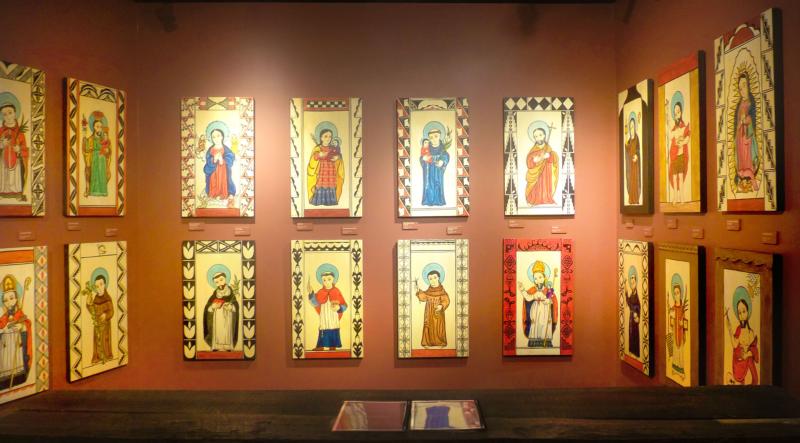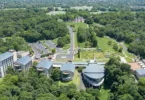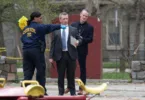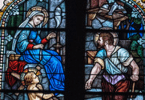
Folk art paintings of 19 Pueblo patron saints are seen in the “We Are Of This Place: The Pueblo Story” exhibit April 19 at the Indian Pueblo Cultural Center in Albuquerque, N.M. (CNS photo/Zita Fletcher)
by Zita Fletcher
ALBUQUERQUE, N.M. (CNS) — In an open square surrounded by sand-colored buildings, hundreds of dancers moved and prayed as one.
Their footsteps shook the ground like thunder, raising clouds of dust under clear blue skies. The air was filled with sounds of chanting and drumbeats. In the midst of the celebration, a statue of St. Dominic stood under an awning adorned with deer antlers, rugs and evergreen branches.
The group was celebrating the annual feast day of Santo Domingo Pueblo, home of the Kewa people and one of the 19 Native American Pueblo nations of New Mexico. The feast day honored both the Kewa residents of the pueblo and St. Dominic, their patron saint given by Spanish Franciscan friars centuries ago.
Although Catholicism was introduced to Native Americans amid foreign incursions and painful chapters in history, 18 Pueblo communities continue to celebrate feast days honoring their patron saints as a unique union of traditional Pueblo and Catholic beliefs, said Travis Suazo, cultural and community engagement officer at the Indian Pueblo Cultural Center in Albuquerque.
“I think what has happened over time is that there’s been cultural adaptation and intertwining of the Catholic religion and our indigenous religion and way of life into an overall celebration of all living things,” Suazo explained.
Pueblo Native Americans made their homes in autonomous villages in the American Southwest. For thousands of years, they practiced ceremonial songs and dances as a means of communication with heaven. Rich with symbolism, the prayers present various forms of intercession, including petition and thanksgiving. Dances were held during the summer to pray for rain and autumn harvests.
Pueblo songs and dances represent universal values. “The intentions are for all living people and all living things in this world ultimately to be in balance with each other,” said Suazo, describing the harmonious nature of Pueblo prayer. “That inherently all people are good; and that people are to love one another, respect one another, and treat each other with kindness and compassion.”
The result is a combined form of worship that occurs on tribal feast days — an event sacred to Pueblo people on many levels.
“Our dances and our songs are a connection to our ancestors, our community, our way of life and also to our belief system,” Suazo said. “Our dances are examples and iterations of prayer.”
The Indian Pueblo Cultural Center, founded in 1976, is among the few U.S. museums that is both about Native Americans and owned and operated by Native Americans. It is dedicated to preserving the culture and history of Pueblo Indians, who are different from other Native American nations.
“We have never been forcibly removed from our traditional homelands as unfortunately other tribes have. We remain very connected to the sense of place,” said Suazo, a member of Laguna, Acoma and Taos pueblos.
“We continue to occupy and visit important ceremonial places that our ancestors have visited. We continue to practice our way of life as our ancestors have to this day,” he said, adding that the Pueblo people maintain their strong cultural connections in balance with a modern, mainstream society.
Since feast days are sacred, no photography is allowed. However, at the IPCC, Pueblo people share dances and explain sacred symbolism to respectful outsiders. The IPCC also collaborates with other Native Americans of New Mexico (including the nomadic Apache and Navajo tribes) to share history, art, culture and food.
The center’s new exhibit, “We Are of This Place: The Pueblo Story,” opened in April and was the first in a series of special events. It provides insights and features high-tech interactive exhibits about Pueblo cultural heritage. Great detail was taken to provide an immersion experience. Native music, audio displays with greetings in Pueblo languages, foam adobe bricks for kids to build villages, and a vast array of Pueblo art are on display. The exhibit even contains a typical grandmother’s kitchen with real recipe cards for traditional food.
“The exhibition,” Suazo noted, “really is a wonderful example of everything about who we are as Pueblo people from a Pueblo perspective.”
One area of the exhibit contains devotional folk art (retablo) paintings of the Pueblo patrons, including St. Joseph (Laguna Pueblo), St. Bonaventure (Cochiti), St. Dominic (Santo Domingo/Kewa), St. Francis of Assisi (Nambe), St. Stephen of Hungary (Acoma), St. Ann (Santa Ana), St. Anthony (Sandia), and St. Jerome (Taos).
The center offers more information about feast days, guidelines for visitors and dates that the villages are open to the public.
A tribe’s feast day is a much-anticipated event, with families spending much time preparing. Visitors travel from near and far to attend celebrations. A statue of each Pueblo’s patron saint occupies a place of honor amid dances and songs. Every tribe has unique traditions influenced by their village’s geographic location. What each pueblo has in common is a tradition of hospitality — the opening of hearths and homes to family members, friends and non-Native guests. Tourists also are welcome.
“I think culturally, the celebration of community, of family, of giving thanks and being a part of ceremony is very important to not only Pueblo people but to all indigenous people,” Suazo said.






